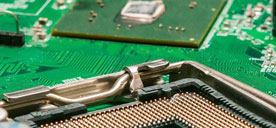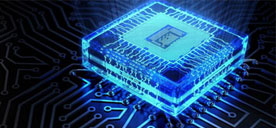Semiconductor Giants Announce Breakthrough in 2nm Chip Technology
2023/7/5 17:11:42
Views:
The relentless pursuit of making technology faster, more efficient, and smaller has always driven innovation in the semiconductor industry. Today, we stand at the precipice of a significant breakthrough that could redefine the dynamics of computing power, energy efficiency, and even the world's carbon footprint.
IBM, the semiconductor titan, recently announced a pioneering development in the field: the world's first 2 nanometer (nm) chip technology[[1](https://newsroom.ibm.com/2021-05-06-IBM-Unveils-Worlds-First-2-Nanometer-Chip-Technology,-Opening-a-New-Frontier-for-Semiconductors)]. IBM's new 2nm chip technology is expected to take a giant leap in performance and energy efficiency, meeting the increasing demand for advanced chip performance, especially in the era of hybrid cloud, artificial intelligence (AI), and the Internet of Things (IoT).
Revolutionizing Power and Performance
IBM's novel 2nm chip is projected to achieve an impressive 45% higher performance or a whopping 75% lower energy use than the most advanced 7nm node chips today[[1](https://newsroom.ibm.com/2021-05-06-IBM-Unveils-Worlds-First-2-Nanometer-Chip-Technology,-Opening-a-New-Frontier-for-Semiconductors)].
For a practical perspective, these 2nm chips could quadruple the battery life of cell phones, meaning users would only need to charge their devices once every four days[[1](https://newsroom.ibm.com/2021-05-06-IBM-Unveils-Worlds-First-2-Nanometer-Chip-Technology,-Opening-a-New-Frontier-for-Semiconductors)]. Considering the number of devices each of us uses daily, this could be a game-changer.
Data centers, which account for 1% of global energy use, could see their carbon footprints drastically reduced if they switched their servers to 2nm-based processors. The enhanced efficiency and performance of these chips could speed up laptops' functions, contributing to quicker processing in applications, assisting in language translation more easily, and providing faster internet access. Even the burgeoning field of autonomous vehicles stands to gain, with faster object detection and reaction times.
Innovating Beyond the Status Quo
The development of this 2nm chip was no small feat. It was a product of sustained investments and collaborative R&D, resulting in an industry-first architecture that can fit up to 50 billion transistors on a chip the size of a fingernail[[2](https://research.ibm.com/blog/2-nm-chip)]. That's over three times the transistor count on Apple's latest M1 chip, which houses 16 billion transistors[[3](https://cmte.ieee.org/futuredirections/2021/06/25/going-beyond-impossible-2nm-chip-technology/)].
IBM's achievement, however, is not merely about technical advancement. The economic implications of this innovation are significant. While the cost per transistor has not been decreasing since 2015, contrary to Moore's law, the advent of these powerful chips could potentially shift market expectations and drive a new kind of Moore's law - one of increased intelligence based on data availability[[3](https://cmte.ieee.org/futuredirections/2021/06/25/going-beyond-impossible-2nm-chip-technology/)].
With such advancements on the horizon, the future of semiconductor technology seems ripe with endless possibilities. As we transition towards a more digital and connected world, these breakthroughs could underpin the next generation of devices and systems, transforming industries and reshaping our day-to-day lives.
Impact Across Industries
The ripple effect of this technological leap would be felt across numerous industries. In the world of telecommunications, for instance, 2nm chips could support the widespread deployment of 6G networks, powering faster, more reliable connections and enabling a new era of immersive applications.
In the healthcare sector, these chips could enhance the capabilities of medical devices, allowing for more detailed imaging, quicker data processing, and potentially enabling real-time diagnostics at the point of care. This could revolutionize patient care, particularly in remote or underserved areas where access to specialists or advanced equipment is limited.
For the automotive industry, where the electrification and automation of vehicles is already underway, 2nm technology could provide the power efficiency and computing performance necessary for the next generation of electric vehicles and autonomous driving systems. The resultant vehicles would not only be more energy-efficient, but also safer and smarter.
The Road Ahead
While the announcement of 2nm chip technology represents a significant breakthrough, it's important to remember that it's not yet ready for mass production. IBM expects that this technology could be ready for the marketplace by 2024 or 2025, assuming the usual timeline of technological advancements in the semiconductor industry.
The advent of 2nm technology has set a new benchmark in the semiconductor industry, paving the way for continued innovation. This announcement not only indicates a technological breakthrough but also holds promise for a future of transformative advancements across various industries, from telecommunication and healthcare to automobiles and beyond.
As we stand on the threshold of the next technological revolution, the potential applications and impact of these ultra-efficient, high-performance chips are limitless. The semiconductor industry, in its ceaseless quest for innovation, is once again poised to redefine our understanding of what is possible, shaping a future where the digital and physical worlds intertwine seamlessly.
IBM, the semiconductor titan, recently announced a pioneering development in the field: the world's first 2 nanometer (nm) chip technology[[1](https://newsroom.ibm.com/2021-05-06-IBM-Unveils-Worlds-First-2-Nanometer-Chip-Technology,-Opening-a-New-Frontier-for-Semiconductors)]. IBM's new 2nm chip technology is expected to take a giant leap in performance and energy efficiency, meeting the increasing demand for advanced chip performance, especially in the era of hybrid cloud, artificial intelligence (AI), and the Internet of Things (IoT).
Revolutionizing Power and Performance
IBM's novel 2nm chip is projected to achieve an impressive 45% higher performance or a whopping 75% lower energy use than the most advanced 7nm node chips today[[1](https://newsroom.ibm.com/2021-05-06-IBM-Unveils-Worlds-First-2-Nanometer-Chip-Technology,-Opening-a-New-Frontier-for-Semiconductors)].
For a practical perspective, these 2nm chips could quadruple the battery life of cell phones, meaning users would only need to charge their devices once every four days[[1](https://newsroom.ibm.com/2021-05-06-IBM-Unveils-Worlds-First-2-Nanometer-Chip-Technology,-Opening-a-New-Frontier-for-Semiconductors)]. Considering the number of devices each of us uses daily, this could be a game-changer.
Data centers, which account for 1% of global energy use, could see their carbon footprints drastically reduced if they switched their servers to 2nm-based processors. The enhanced efficiency and performance of these chips could speed up laptops' functions, contributing to quicker processing in applications, assisting in language translation more easily, and providing faster internet access. Even the burgeoning field of autonomous vehicles stands to gain, with faster object detection and reaction times.
Innovating Beyond the Status Quo
The development of this 2nm chip was no small feat. It was a product of sustained investments and collaborative R&D, resulting in an industry-first architecture that can fit up to 50 billion transistors on a chip the size of a fingernail[[2](https://research.ibm.com/blog/2-nm-chip)]. That's over three times the transistor count on Apple's latest M1 chip, which houses 16 billion transistors[[3](https://cmte.ieee.org/futuredirections/2021/06/25/going-beyond-impossible-2nm-chip-technology/)].
IBM's achievement, however, is not merely about technical advancement. The economic implications of this innovation are significant. While the cost per transistor has not been decreasing since 2015, contrary to Moore's law, the advent of these powerful chips could potentially shift market expectations and drive a new kind of Moore's law - one of increased intelligence based on data availability[[3](https://cmte.ieee.org/futuredirections/2021/06/25/going-beyond-impossible-2nm-chip-technology/)].
With such advancements on the horizon, the future of semiconductor technology seems ripe with endless possibilities. As we transition towards a more digital and connected world, these breakthroughs could underpin the next generation of devices and systems, transforming industries and reshaping our day-to-day lives.
Impact Across Industries
The ripple effect of this technological leap would be felt across numerous industries. In the world of telecommunications, for instance, 2nm chips could support the widespread deployment of 6G networks, powering faster, more reliable connections and enabling a new era of immersive applications.
In the healthcare sector, these chips could enhance the capabilities of medical devices, allowing for more detailed imaging, quicker data processing, and potentially enabling real-time diagnostics at the point of care. This could revolutionize patient care, particularly in remote or underserved areas where access to specialists or advanced equipment is limited.
For the automotive industry, where the electrification and automation of vehicles is already underway, 2nm technology could provide the power efficiency and computing performance necessary for the next generation of electric vehicles and autonomous driving systems. The resultant vehicles would not only be more energy-efficient, but also safer and smarter.
The Road Ahead
While the announcement of 2nm chip technology represents a significant breakthrough, it's important to remember that it's not yet ready for mass production. IBM expects that this technology could be ready for the marketplace by 2024 or 2025, assuming the usual timeline of technological advancements in the semiconductor industry.
The advent of 2nm technology has set a new benchmark in the semiconductor industry, paving the way for continued innovation. This announcement not only indicates a technological breakthrough but also holds promise for a future of transformative advancements across various industries, from telecommunication and healthcare to automobiles and beyond.
As we stand on the threshold of the next technological revolution, the potential applications and impact of these ultra-efficient, high-performance chips are limitless. The semiconductor industry, in its ceaseless quest for innovation, is once again poised to redefine our understanding of what is possible, shaping a future where the digital and physical worlds intertwine seamlessly.
Related Information
-
-
Phone
+86 135 3401 3447 -
Whatsapp





